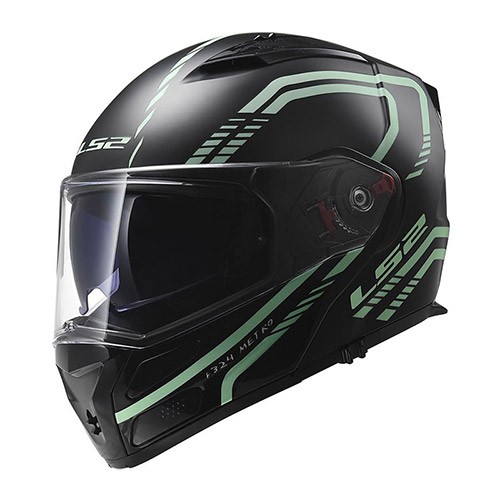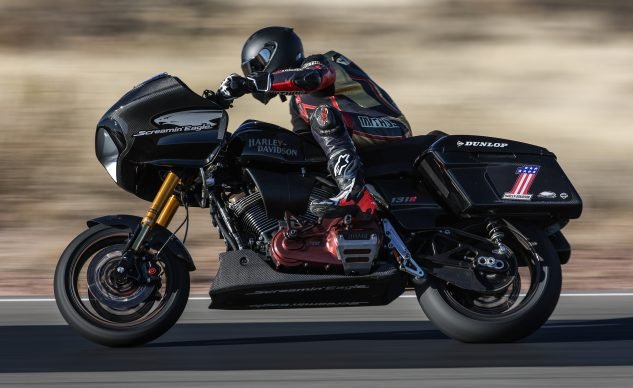
Kyle Wyman knows a thing or two about superbikes. Having ridden quite a few over the years as a MotoAmerica rider, and having built some himself as a MotoAmerica team owner – including the Ducati Panigale V4R he campaigned most recently – the 2021 MotoAmerica King of the Baggers champion didn’t mince his words when describing the synergy between himself, Harley-Davidson, and the Road Glide he took all the way to the title.
“We’re developing superbikes,” he said. “We’re just starting from a different platform.”
The big takeaways are the thunderous torque and surprising agility coupled with absolutely perfect fueling.
+ Highs
|
– Sighs
|
It’s true. The recipe for building a superbike is to take a motorcycle off the showroom floor and make it as fast as it can possibly be. The holy grail is to have the manufacturer that made the bike in the first place partner with you to achieve that mission. A quick look at the Harley-Davidson Screamin’ Eagle factory Road Glide race bike should be enough to tell you this ain’t your average Road Glide. But once you start digging in and getting a close look, you really start to realize how trick this bike really is. This is a full factory effort.

A superbike disguised as a bagger.
There’s No I In Team
To really appreciate this machine, let’s take a brief history lesson. The King of the Baggers championship started out as just a single exhibition race at the end of 2020, won by Tyler O’Hara aboard an Indian. It was so well received that MotoAmerica decided to expand upon it for 2021 with a three-race series, with the first round last April.

This is the 2022 Harley-Davidson Road Glide ST. It’s meant for cruising the streets. Look below for its transformation.
In January of 2021, only four months before round one, Harley-Davidson brass gave the green light for its factory engineers to build their own entry into the series and officially expand the age-old Harley vs Indian rivalry away from dirt ovals and onto pavement. But there was a catch: the team would have to build the bike on their own time. They still had day jobs at Harley after all.
Undeterred, excited, and very stressed, the team went to work (after work). Led by Jason Kehl, Harley-Davidson Engineering Manager by day, he oversaw the program by night and weekends and was responsible for the builds of both Kyle Wyman’s bike, then later the second bike for Kyle’s brother, Travis. Kehl’s two main objectives were simple: Take off as much weight as possible and give it as much power as possible. Wyman’s job was, in his words, “to make the bike feel as close to a sportbike as possible.” Easy on paper. A herculean task in practice. Add in the extremely tight deadline, and the pressure was sky-high.

Racers are going to be racers, and in a matter of months, the skunkworks crew at Harley took a standard Road Glide and turned it into a winning race bike. That’s Kyle Wyman twisting the grip.
Putting a bagger on a diet plan isn’t much different than on any other bike. The difference is the amount of weight you can actually chop off with all the stuff you don’t need. You have the obvious stuff to rid or replace like lights, mirrors, infotainment system, ABS and its related hardware, emissions systems, exhausts, etc. That in itself is a hefty weight reduction, but when you add in the more exotic items like swapping in 17-inch forged wheels, replacing the factory bodywork for carbon fiber pieces, and switching the stock swingarm for an actual billet piece, the weight comes down even more. In this case, the swingarm started as a 400-pound block of aluminum that got whittled down to a measly 18 pounds.
When you add it all up, the bagger race bike comes in at around 635 pounds (race teams are reluctant to give out exact figures) – 207 pounds less than the 842-pound Road Glide on which it’s based! For context, the minimum weight limit for the MotoAmerica Superbike class is 370.5 pounds. Try scraping away two bills worth of weight on a sportbike…
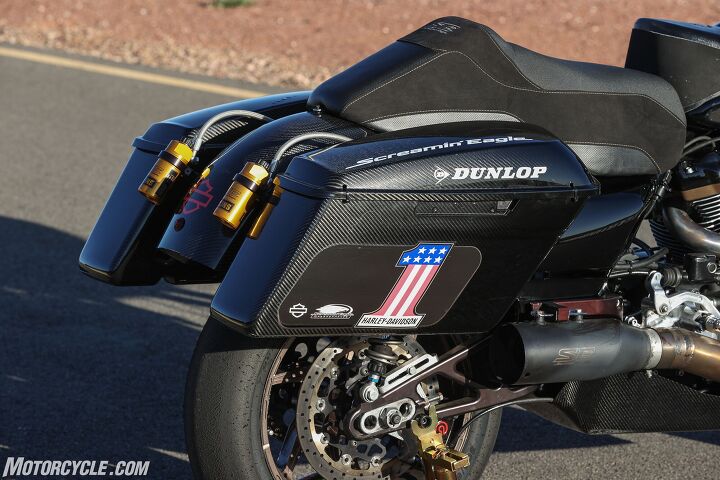
Yes, those are carbon fiber saddlebags.
In this whole equation, adding power is actually the easy part. All Harley had to do was reach into its own Screamin’ Eagle catalog and grab its 131ci (2,146cc) V-Twin crate engine – the biggest and most powerful engine it makes. With such little time to develop the bike, the stock bottom end was kept and only the pistons were changed to add a little more compression. Obvious bits, like the intake and exhaust, were changed, and high-flow injectors replaced the stock ones to keep up with the demands of racing. Odds are there’s more there we don’t know about, but race teams tend to be secretive for obvious reasons. All we’re told is the bike makes over 150 horses and lb-ft of torque. Another impressive figure: at least 120 lb-ft of torque is available at any given time.
On the suspension front, Harley worked with Öhlins USA directly to come up with a unique solution for this unique challenge. It’s not uncommon to borrow existing suspension from another motorcycle and adapt it to fit your application, but simply swapping forks and shocks from a sportbike and onto a bagger isn’t going to cut it. Besides, a factory superbike is supposed to have the best bits possible.
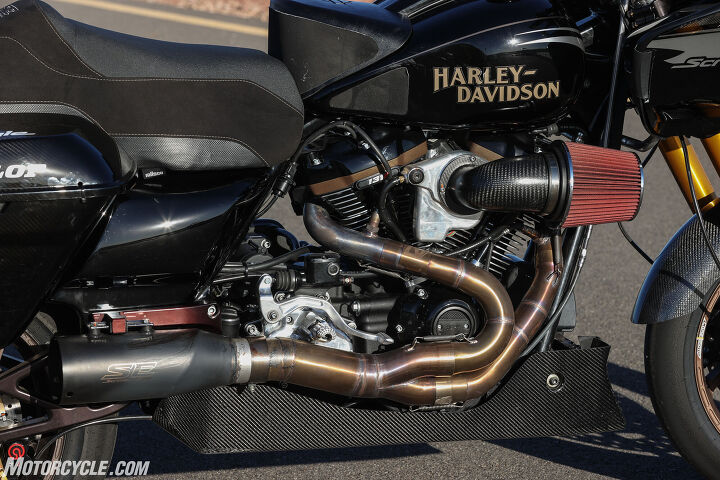
Harley’s 131ci crate engine is at the heart of this beast. Here you can see the custom air intake, exhaust, and carbon fiber belly pan.
To that end, Öhlins developed its FGR 250 Superbike Forks specifically for this application. The fork legs start at 52mm diameter at the top triple clamp, then expand to 58mm at the bottom triple clamp to better handle the forces acting through it during a race. It’s a spring-pressurized fork with full adjustability and has a variable fork length of 770mm – 790mm. Because of the bike’s massive heft, the spring rates range anywhere from 11.0N/mm to 13.0N/mm, depending on the track. Generally speaking, a 10.0N/mm fork spring is already pretty stiff for your standard sportbike. Try these bagger rates on a standard sportbike, and the bike will feel stiff as a board!
In the rear, Öhlins developed a pair of shocks that are similarly as versatile as the fork. A special shim stack was developed specifically for the compression circuit, and obviously, full adjustability is offered. The total shock length measures 330.5mm (13 inches), but interestingly, shock travel is only 81.5mm, or 3.2 inches – 0.2 inches more than the standard Road Glide (granted, the stock shock and the race units are nowhere close to the same). The good news for current or aspiring bagger racers on Harleys is that the same Öhlins fork and shock are now available in the Screamin’ Eagle catalog for anyone who wants to buy them.

More trick bits include Öhlins FGR forks, Brembo calipers, and Coremoto forged wheels. The brake discs measure 310mm. For 2022 the team is switching to Brembo calipers and 330mm discs all around.
Carrying the load of stopping this big beast from massive speeds is a set of 310mm rotors and radial-mount Brembo calipers. Because the bike is so big and there’s so much weight on the rear of the bike, a single 310mm disc and the same Brembo caliper sit in the back of the bike, too. A Brembo 19mm master cylinder modulates the fluid to the front calipers. Kyle says he uses all three brakes to haul the heavy bagger down, though brother, and teammate, Travis Wyman says he only uses the fronts.
The biggest departure when it comes to turning a Road Glide into a racer is getting the rider to feel comfortable on it in the typical sportbike position, because not only did Kyle Wyman need to be able to maneuver the bike the way he likes, but he’s also got to do it while being able to carry sportbike-like lean angles. Considering Harley rates the stock Road Glide as having 32º of lean angle, adding another 23º is a tall order.
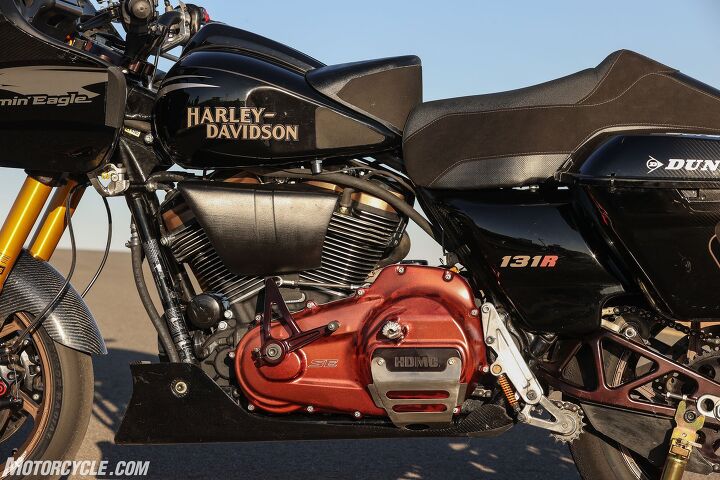
Check out that gargantuan seat! To give Kyle better support for his legs under braking and while leaning over, that tank extender/support was added. Hawkeyes will also notice the fuel tank has been reshaped compared to the stocker to better accommodate the rider’s legs. Other trick bits include the air scoop to cool the rear cylinder, the machined primary cover with footpeg built-in, the chain idlers, and the beautiful billet swingarm.
As it turns out, tall is exactly what the bike is. The fork and shock raise the bike up a little, but getting all the low-hanging parts of the stock bike out of the way made it easier to reach the lean angle requirements. First, though, Kyle made the bike feel like a sportbike from an ergonomic perspective. Low, tapered bars replace the stock pieces, and the custom triple clamps feature adjustable inserts to change the steering offset if needed.
The biggest obvious change comes from the seat itself. A seemingly endless amount of padding was added to raise Wyman high into the air. Then the forward-mounted foot controls of the stock bike were relocated in a more standard sportbike position right underneath the rider’s thighs. However, unlike your average sportbike, you can’t just buy a rearset kit for a Road Glide to move the pegs where you want. In this case, Harley machined all-new engine covers with the footpegs mounted directly to them for the perfect fit. The pegs themselves are tiny stubby pieces, again for maximum clearance, per Wyman’s request. Move to an upswept exhaust, raise the saddlebags higher, and voila – you’ve got yourself a bagger race bike. All in the span of three months.

Another look at the rear wheel and swingarm from the other side. Note the rear brake disc is the same as the front and the radial-mounted caliper is also identical.
Test, Race, And Tune
With just a month to go before the first race of the season at Road Atlanta, the fact the team got the bike built at all was a minor miracle. But one month is not at all enough time to thoroughly sort out a new race bike, let alone one as unique as this. So, the first round would end up being just as much of a test session as a race.
And what a race it was. Wyman led the early stages of the race, getting involved at the halfway point in a heated battle with Indian-mounted Tyler O’Hara, who eventually took the win. As disappointing as the silver medal was, the race proved a valuable data collection exercise. After the race, the data showed that Wyman’s bike was running hot towards the end.

If you watch the first race of the 2021 King of the Baggers series at Road Atlanta, you’ll see the fairing on Wyman’s bike was a closed unit, Wyman’s number 33 boldly emblazoned across the front. Later rounds saw the fairing look like this. Behind that giant mouth lies an auxiliary oil cooler to help keep the engine temps down.
It makes sense, as all that power brings with it all that heat. Also consider that, on average during a race, Wyman has the engine running at 6,000 rpm – 1,000 rpm higher than the redline of a stock Road Glide! This poses a unique issue with the Harley as its V-Twin is cooled only with air and oil. To help cool things down, elongated cylinder fins were added to the top of each cylinder, as close as possible to where the actual combustion occurs.
Putting a radiator in the traditional location behind the front wheel would block air to the front cylinder, so the team opened the fairing where the headlights would normally sit to make room for a secondary oil cooler. This auxiliary cooler, and its placement directly in the flow of oncoming cool air, helps lower the temperature delta significantly. The last thing you can spot is the dedicated scoop on the left side funneling air to the rear cylinder. It makes sense to help cool off the rear cylinder as much as possible since it doesn’t get as much exposure to cool air as the front, but the team’s fluid dynamics research showed the factory horn was placed in such a way that it would disturb the airflow just enough to bring cool air to the rear cylinder. Removing it took away the rear cylinder’s tiny but significant cooling aid. Hence the scoop was born.

Elongated cylinder fins and a scoop also help keep things cool. Personally, I would have preferred they keep the factory horn in place.
Riding A Championship-Winning Bagger
As we now know, Kyle Wyman went on to win the next two rounds of the three-round championship to take the King of the Baggers crown. The updates to the bike’s cooling system deserve a lot of the credit. Remember, the team only came together in January, built a bike in three months, did its first race in April, and concluded the season in July, taking the title in the process. It’s an astonishing achievement in such little time. The bike has since sat idle. Until now.
In an ultra-exclusive test, a select group of journalists were given permission to ride Kyle Wyman’s championship-winning bike, marking the first time anyone outside of Harley-Davidson has been allowed to throw a leg over it. Yours Truly was included in that group. Inde Motorsports Ranch in Wilcox, Arizona would be the venue. Its 21 turns crammed into 2.75 miles come at you in quick succession and are incredibly tricky to get right, as many of the turns look similar to others. Additionally, there are hardly any reference points. Having never ridden the track before, learning it in such limited time, while also getting to grips with this unique race bike would be a big challenge. Oh, and did I mention this would also mark the last time the Glide would be ridden before it makes its permanent home at the Harley-Davidson museum? Paul James, H-D’s head PR man (and a racer himself) made this abundantly clear to everyone before heading out. No pressure.
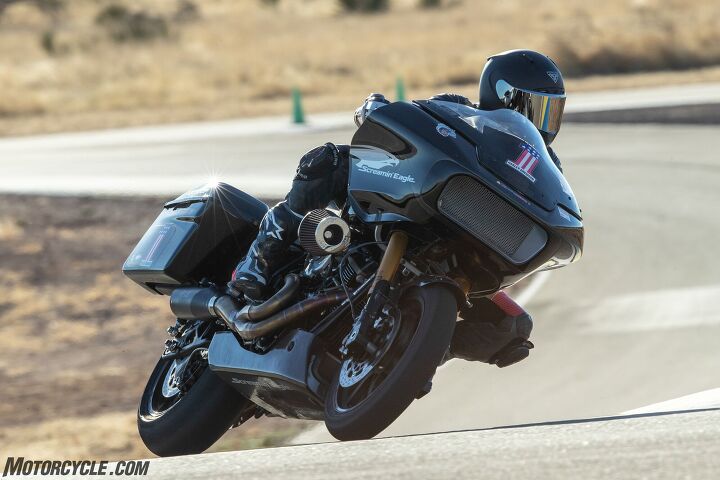
Slow and steady to start things off.
Having the benefit of experience on my side usually gives me some frame of reference whenever I ride a new motorcycle. Not this time. Granted, I’ve raced a Harley-Davidson before, but that doesn’t even come close. The XR1200 was awful in so many ways. This, though, was mesmerizing. Thumb the starter to life and the lazy V-Twin works its way to a thunderous roar. There’s still the signature Harley potato-potato soundtrack, but these are some mean potatoes…
My second thought was “no bike this big has any right being this nimble.” My first? “Damn, this thing is tall.” With such a commanding view of the road ahead thanks to the tall seat, it feels more like Pan America than Road Glide. The bar position feels natural – right in front of me and just slightly low. No ape hangers here. My feet, too, go right where I’d expect them to on a sporty bike, right under my thighs and hips. If I didn’t know any better, I’d think I was on a naked sportbike, not a tricked-out Road Glide. Leaving pit lane bypasses Inde’s first turn, but then turn two, a late-apex, slightly downhill right, comes at you quickly. It leads to the longest straight on the track, so it’s vital to get turn two dialed. The race Glide tipped into the corner quicker than I expected it to, which was clearly a surprise, then with a long straight ahead of me, the only thing left to do was turn the throttle to the stop.
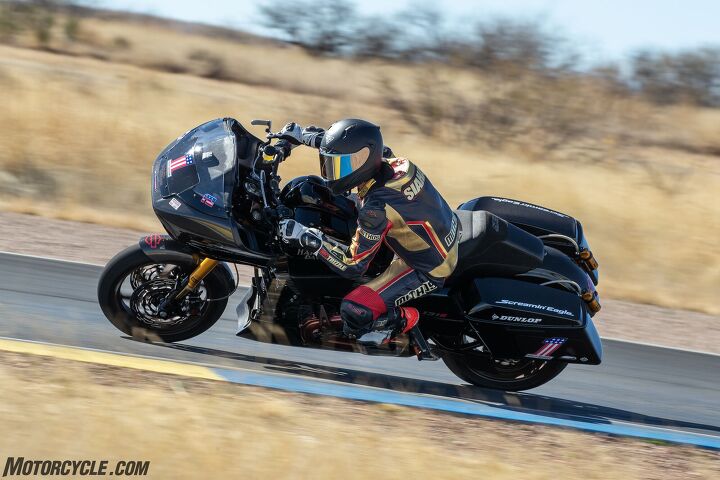
Here, the big Twin roars as all 150-plus horses are let loose. Unlike a four-cylinder screamer, where the sound of the wailing engine audibly matches the amount of ground you’re covering, the Harley’s two coffee cans inside those cylinders sound downright lazy in comparison, as the bagger’s 6,800-rpm redline is about half what those four-bangers can do. Nonetheless, the ground underneath is still flying past at a deceptively quick pace. There’s a certain learning curve needed to readjust to the sound and the pace, but the biggest learning curve is not having a quick shifter or autoblipper to rely on. Shifts are done the old-fashioned way and in the reverse shift pattern. Shift throws are long (this is still a cruiser engine after all), and I missed a few, but that’s all the more reason to learn quickly and move your foot all the way up or down to complete a gear change. Fortunately, the bagger only needs four gear changes per lap at Inde. With so much torque at your disposal and a tight infield to navigate, nearly all of the lap is done in second gear.
Being so used to judging which gear to be in based on engine sounds, the low-revving nature of the race bike threw me off at first, but as I spun up the rear tire over a patch of sealant, I quickly realized three things. First, I was getting sideways on a motorcycle I absolutely could not crash. Second, there was a crazy amount of torque available. And third, the perfect fueling of the engine combined with its slow-revving nature meant I could catch the slide easily and dial back my wrist just enough to bring the tire back in line. Whew.
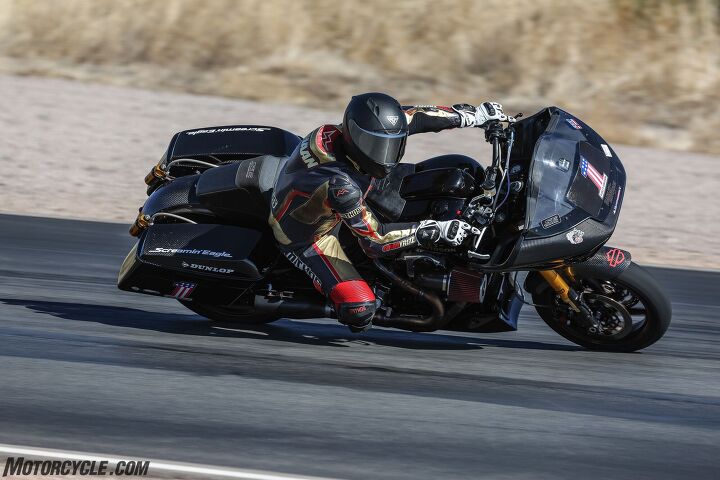
It may not seem like it, but I really was trying to get my knee down.
With only four laps in my first session and three laps in my second, there was a lot to process. Sorting through the engine went fairly quickly, but wrapping my head around how far I could lean the bike was another matter. Again, it’s surprising how nimble and agile this giant beast of a motorcycle is. Despite having the stock frame and geometry settings we’re told are very close to stock (which, clearly, are up for interpretation), the bagger race bike leans into turns quickly. For a cruiser, anyway. The wide bars clearly help with that, but so do the 17-inch forged wheels. The light unsprung mass helps the bike flick and the Dunlop slicks obviously stick – but being so high up it was hard to gauge just how far I was leaning over since my knee pucks were nowhere near the ground. Now I get why Wyman wears thicker rain knee pucks while racing the bagger.
From a behavioral standpoint though, the Glide was responding to all the same inputs I’d give any other motorcycle. Braking from the Brembo calipers was strong and surprisingly uneventful, but even more braking power certainly wouldn’t be a bad thing (then again, I like having tons of stopping power). Since I’m a little particular with my brakes though, I would have liked just a hair more feel at the lever to be able to modulate. Of course, with hardly any laps on the bike, I think more seat time would be enough to adapt my riding style to get used to the stopping power available.

None of that took away from the surprising stability the bike exhibits trailing the brakes into a corner. Sure, the long wheelbase helps, but a confident front end goes a long way in racing. With only seven laps at my disposal, I was starting to get comfortable with the track and ready to push the bike… mid-way through lap six. So, unfortunately, these very crude initial impressions are all I’ve got.
Still, the big takeaways for me are the thunderous torque and surprising agility coupled with absolutely perfect fueling. With more time at my disposal, it would have been a real treat really getting to know the 2021 King of the Baggers championship-winning bike a little better, as I was just scratching the surface of its potential. This Screamin’ Eagle Road Glide race bike is every bit a superbike disguised as a bagger, just as Kyle said.

We are committed to finding, researching, and recommending the best products. We earn commissions from purchases you make using the retail links in our product reviews. Learn more about how this works.
Become a Motorcycle.com insider. Get the latest motorcycle news first by subscribing to our newsletter here.
